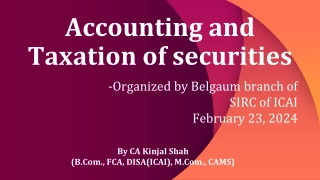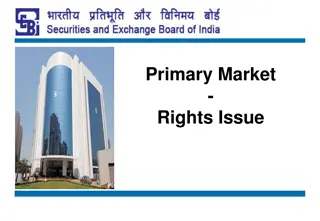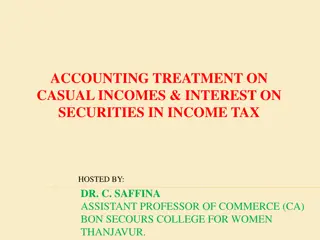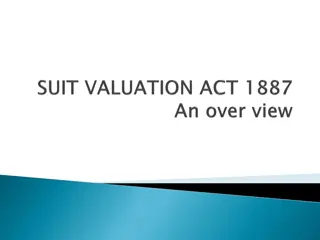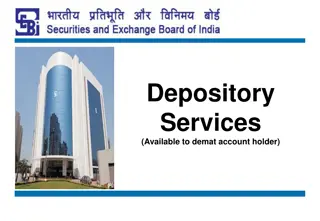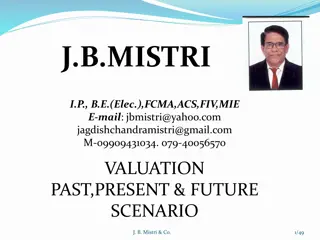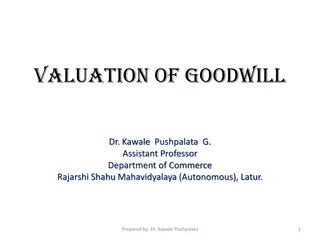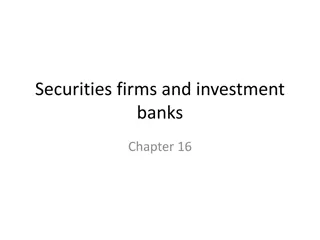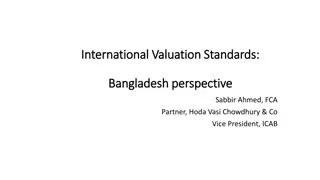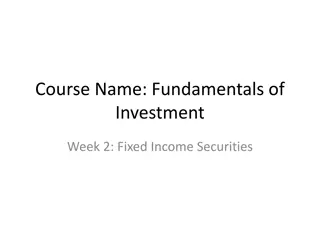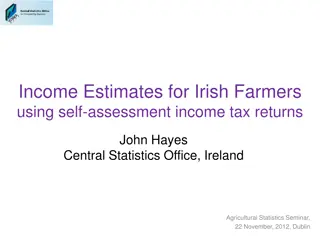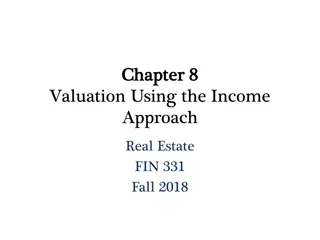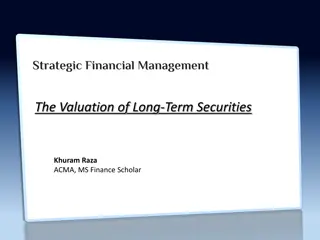Understanding Valuation of Fixed Income Securities
Explore the valuation process for fixed income securities like bonds with a focus on characteristics, capitalization of cash flows, and bond yields. Learn about the features of fixed income securities and how to calculate their present value based on cash flows and discount rates.
Download Presentation

Please find below an Image/Link to download the presentation.
The content on the website is provided AS IS for your information and personal use only. It may not be sold, licensed, or shared on other websites without obtaining consent from the author. Download presentation by click this link. If you encounter any issues during the download, it is possible that the publisher has removed the file from their server.
E N D
Presentation Transcript
Unit 3: Valuation Of Fixed Income Securities Guided by: Dr. Ambrish (Assitant Professor) Prepared by: Arjun Yadav (Research Scholar)
Characteristics Of Fixed Income Securities (Debt And Preferred Stock) Meaning: Fixed income securities are financial claim with promised cash flows of fixed amount paid at fixed dates. Unlike variable income securities, where payments change based on short term interest rates, payments of a fixed income securities are known in advance. Features: Fixed income securities have lowest risk. Fixed rate of return. These fixed income securities are n0t for the capital appreciation. These securities are liquid in nature.
Capitalization of cash flows from the asset and risk free rate When a security is to be valued on the capitalised value, we need to first derive the required rate of return at which investor security. value its The minimum rate of return that the investor wishes to earn is known as required rate. Itconsistsof: The risk free rate(equal foreach security) The risk premium(adjusted according to the risk) Req. rate of return(k)=Ir + rp ,where Ir=risk free rate ,rp=risk premium, k=the required rateof return
Capitalisation of cash flows When we calculating the value of security we apply the discounting technique to find the capitalised value. PVs=CF/(1+k)+CF/(1+k)2+ .CF/(1+k)n where, PVs= present value of security, CF= cash flow at the end of an year, k=discount rate, n=life span of security(in years) At different point of risk the discounting rate is fluctuating, higher the risk high discount rate and vice-versa.
Valuation of bonds Meaning of Bond: It is a agreement between investor and Govt. or company or Financial institution, where investor lend a certain amount at a certain rate. It is a financial instrument which creates liability over the institution, bonds rate of return is based on its risk associated. Features of bonds: Face value Redemption value Maturity period Rate of Interest Market value
Bonds Value and Yields Bonds are classified into three types: 1. Bonds with finite maturity date 2. Yield to maturity 3. Perpetual bond/ Perpetuity Bonds with finite maturity date: 1. PVB= I/(1+kd)t+ m/(1+kd)n Where, PVB= present value of bond I= interest paid M= maturity value n= no. of years kd= required rate of return on bond / market interest rate t= time period of payment receipt
2. Yield to maturity bond: YTM is the total return anticipated on a bond if the bond is held until its matures. YTM is considered a long term bond but it expressed as an annual rate. Yield to maturity is also referred to as book yield or redemption yield . It is based on IRR trail and error method. YTM rate is a predicted rate at which buyer purchase from the market and retain till maturity. PVB=I/(1+k)r+ m/(1+kt)n 3. Perpetual bond: It is also known as perpetual or just a perp, is a bond with no maturity date. Therefore, it may be treated as equity, not as debt. Issuers pay coupons on this bond forever, and they do not have to redeem the principal. Perpetual bond cash flows are, therefore, those of a perpetuity. PV= C/R Where, PV= present value C= continuous cash payment R= interest rate or yield
Bond value Theorems These are the basic rules which are very relevant in consideration with bond: Cause Effect Required rate of return= coupon rate Bond sell at par value Required rate of return> coupon rate Bond sell at discount Required rate of return< Coupon rate Bond sell at premium Greater the bond price change with a given change in the required rate of return. Longer the maturity of the bond
Valuation of Preferred stock Valuation of Redeemable Preference Share: Redeemable preference share valuation same like fixed maturity valuation bond. PVp = D/(1+kp)1 + D/(1+kp)2+ M/(1+kp)n PVp=D/(1+kp)t + M/(1+kp)n Where, PVp= present value of redeemable preference share, D= dividend per preference share M= maturity value n= no. of years kp= required rate of return Valuation of irredeemable preference share: Those share which have not any maturity time and fixed maturity value. Irredeemable preference share value =Dividend/Required return on preference share


